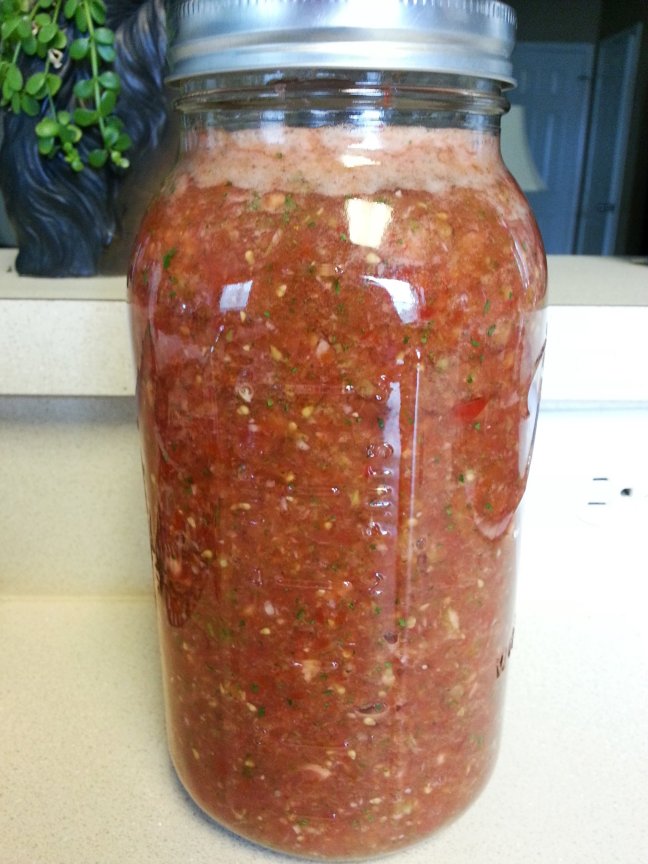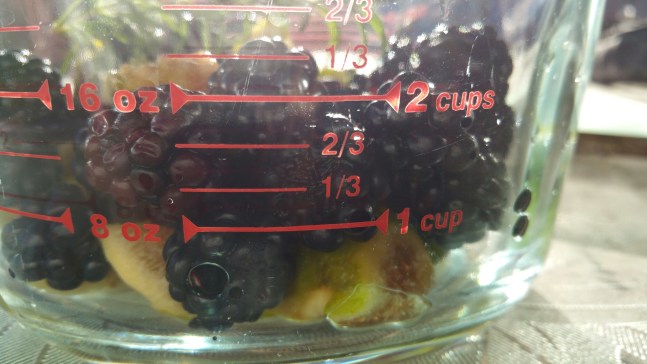While we had plenty of rain this year for my vegetables it was a poor year for fruit. We got so much rain this year that the peaches all aborted and the limbs oozed sap trying to find a way to compensate for the deluge. My persimmon also dropped most of its fruit in response to the excess rain. The only spring fruit that survived this year was a large Breba crop of figs and first year canes with sour blackberries.

Most people with figs toss the Breba (or spring/early summer) crop. The fruit is generally not as good as main crop figs, as they are watery and bland. Although I could have tossed it all in the compost pile, I thought I’d find something more immediately useful for them. That’s when I came across a recipe for something called a Shrub.


I am not a recent convert to homemade fermented prebiotic foods. I’ve been making an awesome fermented summer salsa for the last seven years, and I can’t tell you how delicious a home ferment can be! It’s one of those things that once you try it: you jump in with both feet!

Fermentation is one of those old time skills (like home canning) that make you nervous the first few times you do it. Mysterious and seemingly a little dangerous: your first foray into fermentation can make you wonder how anything that sits out on the counter for a week can possibly be healthy or taste good. All I can say is: give it a try. If you follow proven fermentation recipes, I promise you won’t get sick and you will love the end result!
Shrubs are a great way to use up fruit that you would otherwise have trouble finding a use for. The definition for a Shrub (thanks to Wikipedia):
“A shrub can also refer to a cocktail or soft drink that was popular during America’s colonial era, made by mixing a vinegared syrup with spirits, water, or carbonated water. The term “shrub” can also be applied to the sweetened vinegar-based syrup, from which the cocktail is made; the syrup is also known as drinking vinegar. Drinking vinegar is often infused with fruit juice, herbs and spices for use in mixed drinks.”
I saw a drinking vinegar (aka shrub) for sale in a catalog and thought: I bet I could make this! Which after some research, I found that: yes, these are great homemade! There are a variety of shrub recipes out there. Some require cooking, I prefer my fruit (and veggies, like the salsa ferment I make) fresh. There were plenty of recipes to choose from.
For my shrub I chose to make my own recipe after examining a few shrub recipes online. I mixed some flavors from what I had on hand: figs, blackberries, cracked black peppercorns and some home grown rosemary.
I decided on using apple cider vinegar for the vinegar because I tried a spoonful with the fruit I had macerated. I thought the fruit mixture was good with the apple cider vinegar. (Champagne vinegar would also be nice.) I tried a good quality balsamic vinegar with the macerated fruit and that was a definite “No”. To me the balsamic vinegar puts a “rotten fruit” taste in it that I couldn’t handle.
When you are making a homemade drinking vinegar (or shrub) you want half of your fruit to be very sweet: my Breba crop of figs, and half to be something tart: the blackberries (tart cherries or elderberries would work, too.) Luckily, blackberries are usually for sale at the grocer (fresh or frozen) and the ones from the store are always tart.
You could also add a little lime or lemon juice if you don’t want to go the blackberry/cherry route. For something sweet (other than figs) I would think blueberries, strawberries, plums, persimmons, grapes or peaches would work well. You are going to be adding quite a bit of sugar, so having something tart makes for a kind of depth of flavor that I really enjoy.(If you are avoiding sugar, like I am, assemble the fruit concoction without the sugar and add a few drops of stevia or other low glycemic sweetener to each glass as you serve it. Do not try to to add a sugar substitute to your shrub during the fermentation period.)
Taste it after you add the sugar (if you are using sugar) and you have macerated the fruit. That’s when to add other flavors or adjust the fruit ratio until you are happy with the flavor. It will only become a deeper, more complex version of the fruit (and sugar) combination, from here on out.
Here’s how I made mine:
2 cups washed fruit (1 cup tart: I used blackberries and 1 cup sweet: I used figs. Cut up larger, or thick skinned, fruit. I quartered the figs.)
1 1/2 cups sugar, or skip the sugar and sweeten it with sugar substitute, as you are serving it.
One sprig rosemary
2 tsp freshly cracked black peppercorns
1 1/2 cups apple cider vinegar
Mix the sugar in with the fruit until the fruit is coated. Add the fresh cracked pepper. Remove the stem and add the fresh rosemary leaves. Mash the fruit mixture. (I used the pestle, from a mortar and pestle set, in a bowl but you can just use a food processor or even a fork.)
Cover the fruit mixture with plastic wrap (remember to burp the concoction because plastic wrap will contain all of the gases formed in fermentation) or a towel (to keep anything from getting into it) and leave it out out on the counter for 48 hours. After the first 24 hours: stir and crush the fruit again, then let it sit again until the 48 hours has expired.
Add the vinegar and strain the juice through a sieve into a large mason jar. Put the mixture on the counter, or in the fridge, in a mason jar and burp it every once in a while, for at least a week. Your choice. Refrigeration will slow down, but not stop, the fermentation. If you continue to leave it on the counter a “wine” type flavor may develop. I aged mine in the fridge because I like a fresh fruit flavor instead.
Open the jar daily to let gases escape and shake or stir the mixture daily. At the end of a week: add some carbonated water to a drinking glass (I like to use a lime flavored club soda.) Fill the glass 2/3 of the way with the carbonated water: slowly add the shrub until you are happy with the flavor. You should taste the tartness of the vinegar, but: it shouldn’t be overwhelming.
Shrubs remind me of Italian sodas and I can definitely see where our modern day carbonated sodas get their flavors. The shrubs are a wonderful old time way to extend your enjoyment of fruit season and a great way to use up fruit that you would usually have taken from your garden and directly dumped into the compost pile (overly ripe or pest damaged fruit is fine, but if it’s truly rotting or diseased: find something else to use!) You can also use up the tail end of any fruit glut in a Shrub. My children enjoy the shrub as well. It is a healthier alternative to soda.
I like a sprig of mint in mine. Just roll the mint between your fingers and crush it a bit before you put it in. Vodka or rum would also pair well with this, although I usually enjoy mine alcohol free. 
Discover more from Crazy Green Thumbs
Subscribe to get the latest posts sent to your email.









That looks wonderful!
Great post! And all the technical info to make it work. Thank you. I’ve been reading a lot lately about the massive benefits of good bacteria in our guts, as well as how our modern diets don’t supply them or we kill them off with anti-bacterial measures. This would be a really pleasant way to get these pro-biotics into my diet. Happy gut biome, happy life!
Does anyone make cordials anymore? I remember them, but I don’t remember what they were. They were certainly not fermented. Most were made with a variety of fruits, with just a bit of each. Each fruit was added in a layer as it came into season. I must look that one up.
I found this recipe. It’s what I plan to do with my elder flowers next season. Great idea! https://www.bbcgoodfood.com/howto/guide/how-make-cordial
Wow, that does not sound remotely familiar. I have heard of it, but it not what I remember. I should try to find it online. Perhaps the terminology is wrong. They were like the cherries inside of chocolate covered cherries. They were more than cherries though. There were prunes, apricots, peaches, nectarines, maybe plums, and any of the stone fruits. there might have been orange and lemon peel. I do not remember it well enough. There were not many of each,, but a layer of each was added as it came into season, and more booze was added to cover it. In the end, there was quite a mixture of fruits in there. I don’t know what the booze was.
Awesome blog!!!
Thank you! Thanks for coming by.